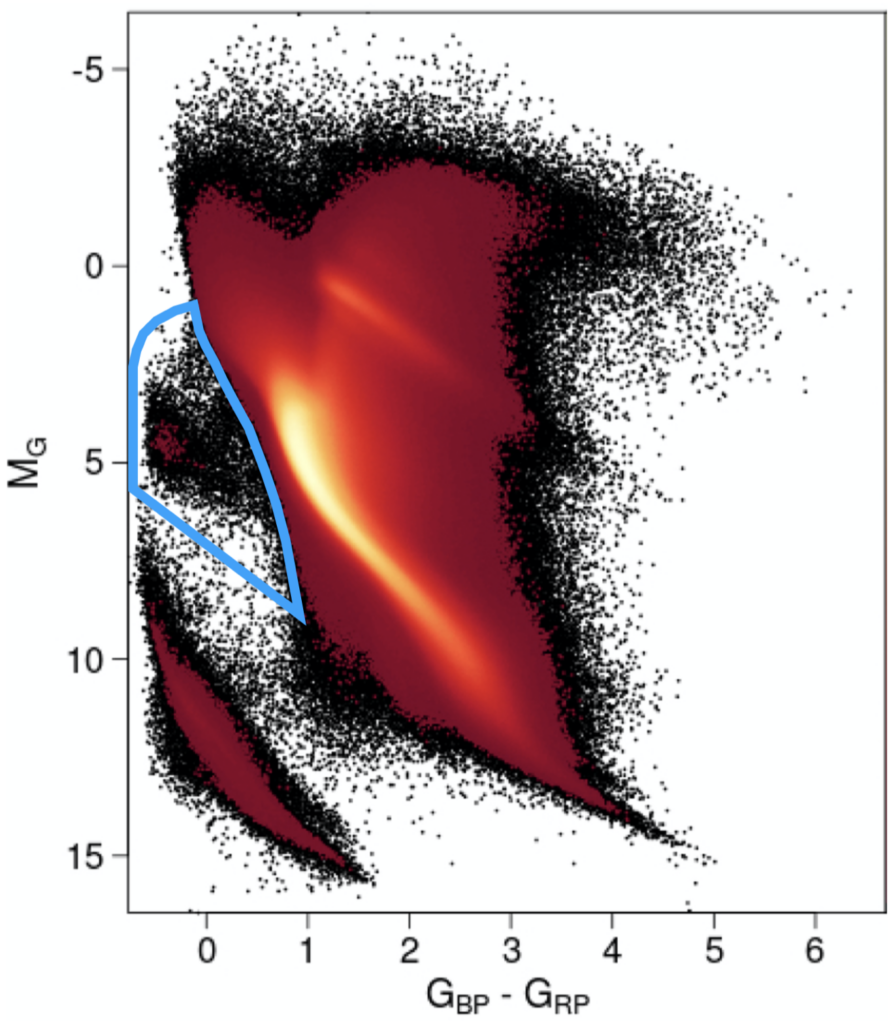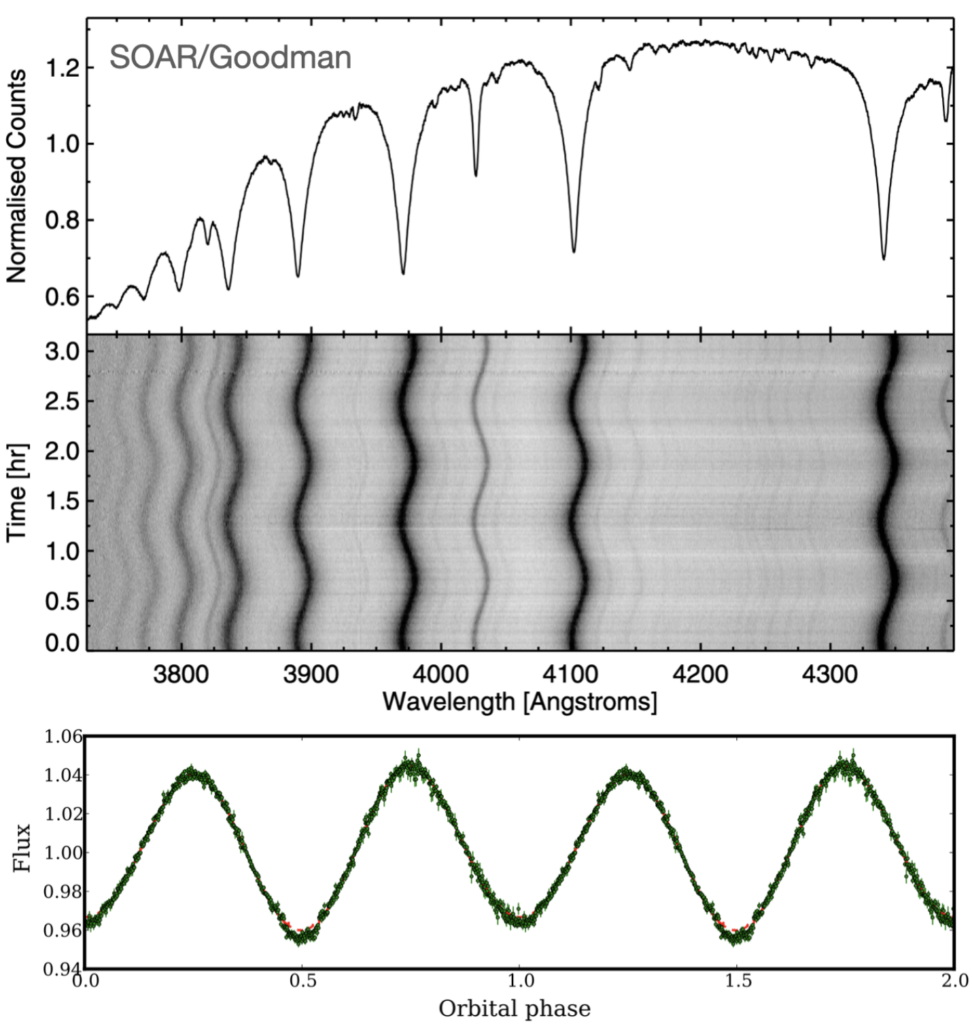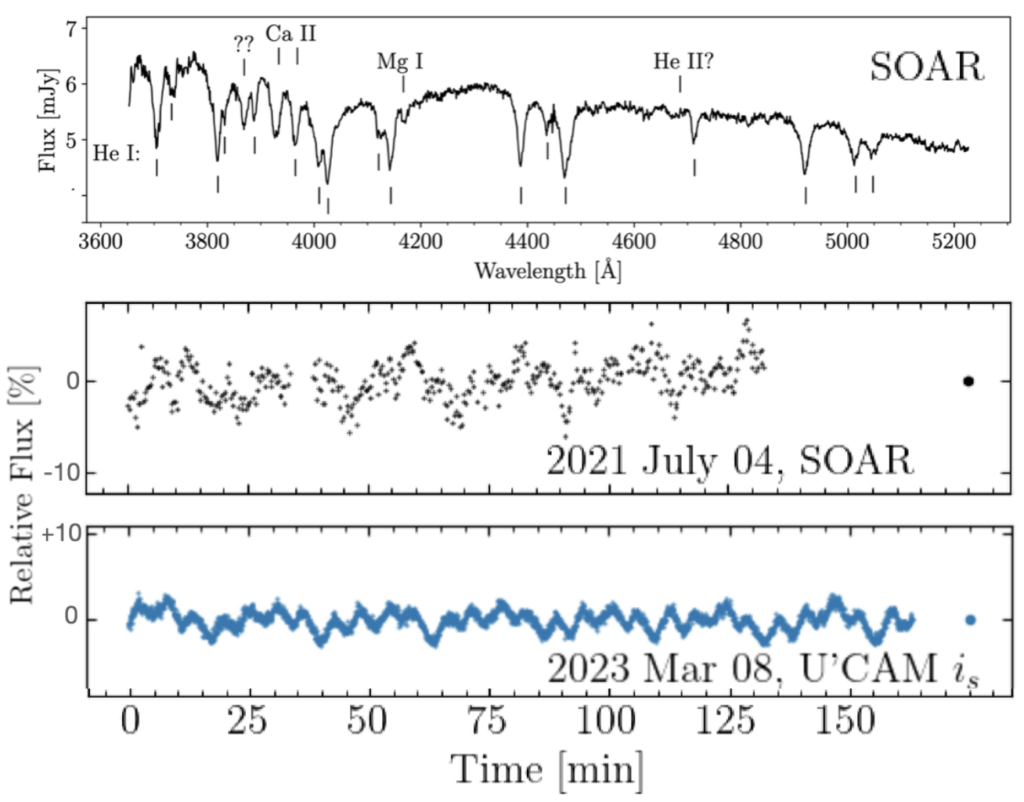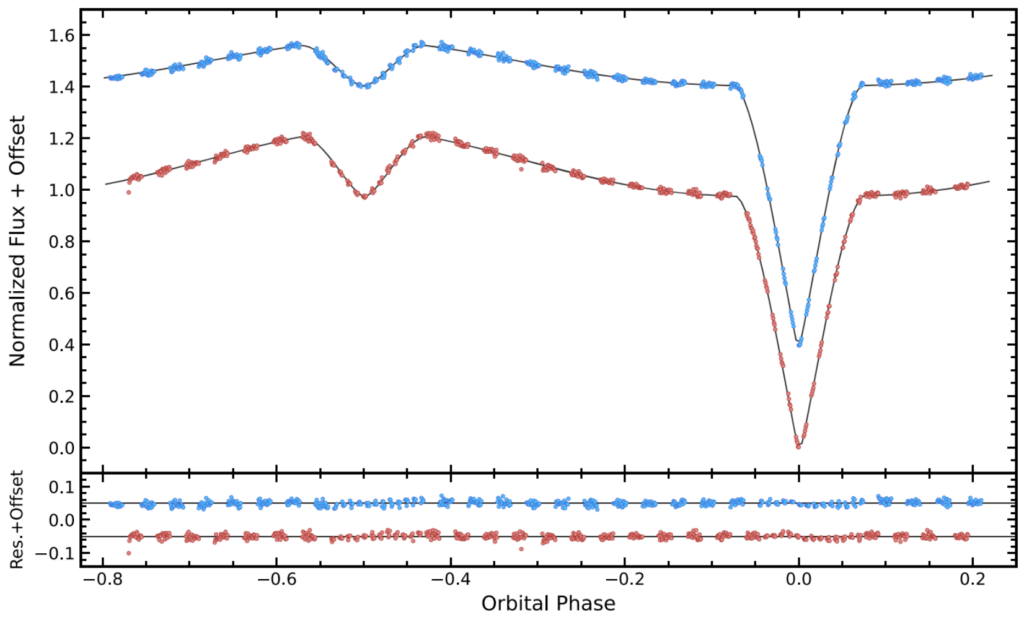RESEARCH

Our research group uses observations of compact stars to improve our understanding of broader areas of astrophysics, including gravitational wave physics, Type Ia supernovae, binary star evolution, and more. Most of this work focuses on an interesting part of the H-R diagram nestled between the white dwarf cooling sequence and main sequence. Collectively referred to as hot subluminous stars, several types of objects have evolutionary tracks passing through this location, including pre-extremely low mass (pre-ELMs) white dwarfs, core He-fusing hot subdwarf stars, post-blue horizontal branch stars, cataclysmic variables, and the recently discovered subdwarf A stars. Essentially all hot subluminous stars share one common trait: binary interactions are necessary for their formation (Pelisoli et al., 2020). Our research focuses on leveraging this fact to gain insight into stellar evolution, Roche lobe overflow (RLOF) process, common envelope (CE) ejection, and other interesting astrophysical phenomena. The broader impacts of this work touch on gravitational wave physics, survivability of exoplanets, Type Ia supernovae, and more. UNC possesses a powerful array of existing and future facilities that are incredibly well-matched to these studies, including SOAR, Argus, Skynet, and Evryscope. We supplement data from those facilities with observations from TESS, Zwicky Transient Facility (ZTF), the SMARTS Consortium telescopes, and (one day) the Nancy Grace Roman Space Telescope. The Goodman Spectrograph on SOAR serves as the workhorse instrument for our group’s research. With its incredible efficiency in the blue, it is well-suited for studies of hot subluminous stars.
If you’re a UNC-CH student who is interested in any of the topics below, please contact me!
Ongoing Projects
The Hunt for Type Ia Supernova Progenitors in our Galaxy
Primary Collaborators: Thomas Kupfer (U. Hamburg), Ingrid Pelisoli (U. Warwick), Stephan Geier (U. Potsdam), Fabian Mattig (U. Potsdam)

Type Ia supernovae are some of the most important standard(izable) candles for measuring the expansion history of the universe. The thermonuclear explosion of a white dwarf exceeding the Chandrasekhar mass can explain their observed properties, but few progenitor systems have been conclusively identified and studied in detail. White dwarf and hot subdwarf binaries play a fundamental role in our understanding of SN Ia. Binary population synthesis models (e.g., Han et al. 2002, 2003) predict that a substantial fraction of hot subdwarf B (sdB) stars should be in tight, post-CE binaries with white dwarfs. With orbital periods ranging from 40 min to several hours, such systems lose orbital angular momentum due to gravitational wave radiation and will eventually undergo mass transfer that, with sufficient stellar masses, could trigger a SN Ia. Working with collaborators Stephan Geier (U. Potsdam), Thomas Kupfer (U. Hamburg), and Ingrid Pelisoli (U. Warwick), we use multi-epoch radial velocity measurements from SDSS, Lamost, SOAR/Goodman, and other facilities, along with time-series photometry, to identify and characterize potential SN Ia progenitors. Our first major discovery was CD-30◦11223, a sdB+WD binary with an orbital period of only 72 min and separation distance of 0.6 R⊙ (Geier et al., 2013). SOAR/Goodman data, shown in Figure 2, played a vital role in our determining its fundamental properties. In about 36 Myr, He mass transfer will commence from the sdB star to the white dwarf. Modeling this process we found that the deto- nation in the accreted He layer is sufficiently strong to trigger the explosion of the C/O core, through the double–detonationa scenario, even though the total mass falls below the Chan- drasekhar limit. CD-30◦11223 represents the first candidate SN Iax progenitor found. Recently, we have also been using time-series photometry from the TESS mission and the Zwicky Transient Facility (ZTF) to uncover additional systems from their ellipsoidal modulations. The most notable of these is HD 265435, a sdB+WD binary with a total mass of 1.65 ± 0.25 M⊙ and orbital period around 99 min. HD 265435 is located less than 500pc from the Sun, making it the closest candidate SN Ia progenitor yet known (Pelisoli et al., 2021).
Example Relevant Papers:
A hot subdwarf–white dwarf super-Chandrasekhar candidate supernova Ia progenitor
Pelisoli, I., Geier, S., Kupfer, T., Heber, U., Irrgang, A., Schneider, D., Bastian, A., van Roestel, J., Schaffenroth, V., Barlow, B.N., 2021, Nature Astronomy, 5, 1052.
A progenitor binary and an ejected mass donor remnant of faint type Ia supernovae
S. Geier, T. R. Marsh, B. Wang, B.H. Dunlap, B.N. Barlow, V. Schaffenroth, X. Chen, A. Irrgang, P. F. L. Maxted, E. Ziegerer, T. Kupfer, B. Miszalski, U. Heber, Z. Han, A. Shporer, J. H. Telting, B. T. Gaensicke, R. H. Østensen, S. J. O’Toole, and R. Napiwotzki 2013, A&A, 554, 54.
Finding/Characterizing LISA Gravitational Wave Verification Sources
Primary Collaborators: Thomas Kupfer (U. Hamburg), Ingrid Pelisoli (U. Warwick), Matthew Green (Tel Aviv U.)
Ultra compact binaries consisting of white dwarfs, neutron stars, and even hot subdwarfs will dominate the sources detectable by the Laser Interferometer Space Antenna (LISA) observatory. They will collectively generate a stochastic foreground signal that must be properly characterized before the full power of LISA can be realized. During our photometric and spectroscopic searches for hot subluminous binaries, we frequently encounter new LISA verification sources, like the AM CVn binary TIC 378898110 we recently announced in MNRAS (Green et al., 2024). With a period of 23 min, TIC 378898110 represents the shortest orbital period binary ever found with TESS. SOAR/Goodman data were vital to its characterization.

There are numerous white dwarf and hot subdwarf binaries that should generate strains above LISA’s detection threshold and be resolved as individual sources. Thus, they serve as important gravitational wave verification sources for the mission. A natural consequence of finding the extreme sdB+WD binaries discussed in the previous section is that we also discover new gravitational wave emission sources for LISA. The characteristic strains of the SN Ia progenitors CD-30◦11223 and HD 265435, for example, place them above the LISA detection limits. Other sub-Chandrasekhar, non-SN Ia proginetor sdB+WD binaries also fall above this threshold, along with numerous double-degenerate WD binaries. Our collaboration has uncovered an additional dozen binaries with ZTF and TESS that will likely be added to this collection, once we solidify their modeling solutions. Obtaining a complete census of all sdB gravitational wave verification sources for LISA drives much of our research on these systems.
Example Relevant Papers:
TIC 378898110: A Bright, Short-Period AM CVn Binary in TESS
Green, M.J., Hermes, J.J., Barlow, B.N., Marsh, T.R., Pelisoli, I., Gaensicke, B.T., Kaiser, B.C., Romero, A., Antunes Amaral, L., Corcoran, K., Grupe, D., Kepler, S.O., Ashley, R.P., Baran, A., Breedth, Elme, Brown, A., Dhillon, V.S., Dyer, M.J., Kerry, P., King, G.W., Littlefair, S.P., Parsons, S.G., Sahman, D.I., Wild, J. 2024, MNRAS, 527, 3445.
An Eclipsing 47-minute Double White Dwarf Binary at 400 pc
Munday, J., Tremblay, P.-E., Hermes, J.J., Barlow, B.N., Marsh, T.R., Parsons, S.G., Jones, D., Kepler, S.O., Brown, A., Littlerfair, S.P., Hegedus, R., Baran, A., Breedt, E., Dhillon, V.S., Dyer, M.J., Gaensicke, B., Green, M., Kennedy, M., Kerry P., Lopez, I., Pelisoli, I., Romero, A.D., Sahman, D., Worters, H. 2023, MNRAS, 535, 1814.
Determining the Influence of Substellar Objects on Stellar Evolution
Collaborators: Veronika Schaffenroth (Tautenberg Obs.), Stephan Geier (U. Potsdam), Isaac Lopez (Iowa State U.), Kyle Corcoran (USNO)

As the progeny of stripped red giants, sdB stars are a natural choice for studying the effects of substellar companions on stellar evolution. A large fraction of them are in very close–but–detached binaries (P < 1 day) with low–mass, M dwarf companions and are easily identifiable from their light curves, which are dominated by a strong reflection effect and, occasionally, eclipses. Since the orbital separations are so small (a < 1 Rsun), the companions in these so–called “HW Vir” systems were previously engulfed by the hot subdwarf’s red giant progenitor and survived the interaction. Consequently, a large study of HW Virs is one of the best avenues for determining the influence of substellar objects on late stellar evolution, and their likelihood of surviving it. To this end, I worked with Veronika Schaffenroth (Tautenberg Obs.) to start the Eclipsing Reflection Effect Binaries from Optical Surveys (EREBOS) project to obtain follow–up photometry and spectroscopy of HW Vir systems discovered by these surveys (Schaffenroth et al., 2019). EREBOS currently consists of 21 investigators located around the world. We pool together resources to obtain high S/N data to solve for each system’s properties.
Our main EREBOS results to date are that (i) brown dwarfs can survive red giant engulfment; (ii) orbits can circularize within 30,000 years during the common envelope phase; (iii) common envelope ejection is not as efficient as previously thought; and (iv) it is possible to determine system inclination without eclipses (Barlow et al., 2024a). Our ultimate goal is to determine the true companion mass distribution and whether there is a mass cutoff for surviving red giant engulfment. At too small a separation, theory predicts the companions might evaporate or merge with the evolving red giant’s core. This limit is not well-constrained by observations. Ultimately, the companion mass distribution generated by EREBOS will help constrain binary population synthesis model parameters related to tidal effects, angular momentum conservation, common envelope ejection efficiency, and binding energies of red giant envelopes. The companion mass–radius relations we derive may even improve our understanding of radius inflation in hot Jupiters.
Example Relevant Papers:
Hot subdwarfs in close binaries observed from space III: Reflection effect asymmetry from relativistic beaming
Barlow, B.N., Parker, I.*, Smith, B.A.*, Kupfer, T., Schaffenroth, V. 2023, Astronomy & Astrophysics, submitted.
Hot subdwarfs in close binaries observed from space II: analysis of the light curves
Schaffenroth, V., Barlow, B.N., Pelisoli, I., Geier, S., Kupfer, T. 2023, Astronomy & Astrophysics, 673, A90.
Hot subdwarfs in close binaries observed from space I: orbital, atmospheric, and absolute parameters and the nature of their companions
Schaffenroth, V., Pelisoli, I., Barlow, B.N., Geier, S., Kupfer, T. 2022, Astronomy & Astrophysics, 666, A182.
Eclipsing Binaries Found by the EREBOS Project: Gaia DR2 6097540197980557440—a Deeply Eclipsing sdB+dM System
Corcoran, K.A.*, Barlow, B.N. Schaffenroth, V., Walser, S.*, Heber, U., Irrgang, A, 2021, Astrophysical Journal, 918, 28.
The EREBOS project — Investigating the effect of substellar and low-mass stellar companions on late stellar evolution: Survey, target selection and atmospheric parameters
Schaffenroth, V., Barlow, B.N., Geier, S., Vuckovic, M., Kilkenny, D., Wolz, M., Kupfer, T., Heber, U., Drechsel, H., Dreizler, S., Kimeswenger, S., Marsh. T., Wolf M., Kreuzer, S., Ziegerer, E. and Freudenthal, J., 2019, Astronomy & Astrophysics, 630, A80.
Searching for New Variables
Collaborators: JJ Hermes (Boston U.), Kyle Corcoran (USNO), Fabian Mattig (U. Potsdam), Dave Kilkenny (U. Western Cape), Veronika Schaffenroth (Tautenberg Obs.)
Description coming soon.
Massive O/B Stars in Multiplet Systems
Collaborators: Petr Harmanec (Charles U.), Petr Zasche (Charles U.), Jaroslav Merc (Charles U.)
Description coming soon.
Asteroseismology of Hot Subdwarfs & Related Objects
Collaborators: Thomas Kupfer (U. Hamburg), Corey Bradshaw (U. Hamburg)
Description coming soon.
